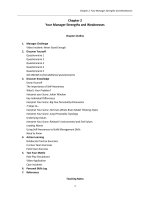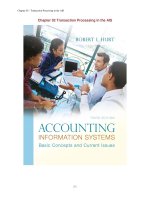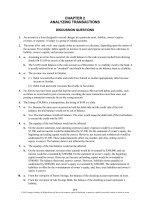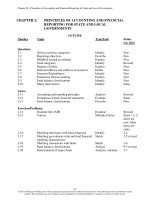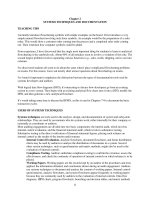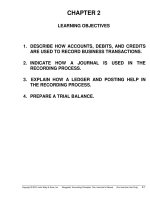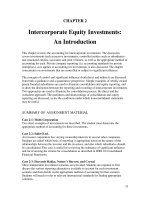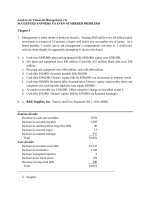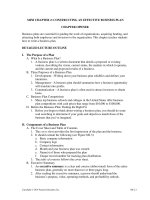Test bank and solution of financial statement auditting environment (2)
Bạn đang xem bản rút gọn của tài liệu. Xem và tải ngay bản đầy đủ của tài liệu tại đây (3.05 MB, 48 trang )
Messier_10eSM_CH_2.pdf
Messier_10e_IM_CH_2.pdf
IPPTChap002.pdf
Chapter 02 - The Financial Statement Auditing Environment
CHAPTER 2
THE FINANCIAL STATEMENT AUDITING ENVIRONMENT
Answers to Review Questions
2-1
Auditors can be classified under four types:
(1) External auditors—Auditors who are referred to as “external” or “independent”
because they are not employees of the entity being audited. Audit financial statements for
publicly traded and private companies, partnerships, municipalities, individuals, and other
types of entities. May also conduct compliance, operational, and forensic audits for such
entities
(2) Internal auditors—Auditors who are employees of individual companies, government
agencies, and other entities. Often conduct financial, internal control, compliance,
operational, and forensic audits within their organizations. In some cases they may assist
the external auditors with the annual financial statement audit. Internal auditors also often
are involved in assurance and consulting engagements for their entities.
(3) Government auditors—Auditors employed by federal, state, and local agencies.
Government auditors are usually considered to be a type of internal auditor. Conduct
audits of activities, financial transactions, and accounts of the federal government. They
also assist Congress by performing special audits, surveys, and investigations. The
majority of the audits are compliance and operational audits. May also investigate for
fraud in government agencies and other organizations subject to federal laws.
(4) Forensic auditors—Auditors employed by corporations, government agencies, public
accounting firms, and consulting and investigative services firms. They are specially
trained in detecting, investigating, and deterring fraud and white-collar crime.
2-2
Examples of compliance audits include (1) internal auditors determining whether
corporate rules and policies are being followed by departments within the organization, (2)
an examination of tax returns of individuals and companies by the Internal Revenue
Service for compliance with the tax laws, and (3) an audit under the Single Audit Act of
1984 to determine whether an entity receiving federal assistance is in compliance with
applicable laws and regulations.
Examples of operational audits include (1) an audit by the GAO of the Food and Drug
Administration to determine the efficiency and effectiveness of procedures for introducing
new drugs to the market, (2) internal auditors examining the effectiveness and efficiency
of funds being spent on the entity’s computer resources, and (3) a university hiring an
external auditor to examine the effectiveness and efficiency of student advisory services.
Examples of forensic audits include (1) an examination by an external auditor of cash
disbursements for payments to unauthorized vendors, (2) assistance by an auditor to a law
enforcement agency in tracing laundered monies by organized criminals, and (3) an
independent auditor helping identify hidden assets as part of a divorce settlement.
Student answers will likely be less detailed but should capture the general idea of each
2-1
© 2017 by McGraw-Hill Education. This is proprietary material solely for authorized instructor use. Not authorized for sale or distribution in any
manner. This document may not be copied, scanned, duplicated, forwarded, distributed, or posted on a website, in whole or part.
Chapter 02 - The Financial Statement Auditing Environment
type of audit.
2-3
During the late 1990s and early 2000s, accounting firms aggressively sought opportunities
to expand their business in nonaudit services such as consulting. This expansion from their
core audit practice, combined with allegations of auditors refusing to challenge
management’s actions, resulted in conflict between regulators and the accounting
profession. Subsequent financial fiascos such as those at Enron, WorldCom, Tyco, and
many others caused investors to doubt the fundamental integrity of the financial reporting
system. Under pressure to restore the public’s confidence, Congress passed the SarbanesOxley Act and created the PCAOB in 2002.
2-4
The accounting profession’s expansion into new areas, combined with changes in the
overall business environment, resulted in new regulations and guidelines. The scandals of
the late 1990s and early 2000s brought into question the profession’s ability to selfregulate, resulting in new legislation. While these changes have caused pain and turmoil,
they highlight the essential importance of auditing in our economic system. Ultimately,
the “back to basics” emphasis, along with auditing firms’ renewed focus on thorough and
effective financial statement audits, will likely prove healthy for the U.S. financial
2-2
© 2017 by McGraw-Hill Education. This is proprietary material solely for authorized instructor use. Not authorized for sale or distribution in any
manner. This document may not be copied, scanned, duplicated, forwarded, distributed, or posted on a website, in whole or part.
Chapter 02 - The Financial Statement Auditing Environment
reporting system and for the profession. Further, somewhat ironically, the SOX-mandated
audit of internal control over financial reporting has brought significant new revenues to
accounting firms.
2-5
Management is responsible to prepare financial statements that fairly present the
company’s financial condition and operations in accordance with established accounting
standards. Note that the auditor’s opinion explicitly states that the financial statements are
the responsibility of management. The auditor is responsible to issue an opinion in regards
to the financial statements prepared by management. In order to issue this opinion, the
auditor must plan and perform the audit in accordance with established standards to obtain
reasonable assurance that the financial statements are free of material misstatement,
whether caused by error or fraud. However, it is important to note that an auditor’s
unqualified opinion does not mean that errors or fraud do not exist but rather that there is
reasonable assurance that they do not exist in material amounts.
2-6
The essential components of the high-level model of business offered in the chapter are:
corporate governance, objectives, strategies, processes, controls, transactions, and
financial statements. Corporate governance is carried out by management and the board of
directors in order to ensure that business objectives are carried out and that company
assets are safeguarded. To achieve its objectives, management must formulate strategies
and implement various processes which are in turn carried out through business
transactions. The entity’s information and internal control systems must be designed to
ensure that these transactions are properly executed, captured, and processed in order to
produce accurate financial statements. It is important that the auditor obtain a firm
understanding of these components in order to understand relevant risks and to plan the
nature, timing, and extent of the audit so that it is efficient and effective.
2-7
The information system must maintain a record of all businesses transactions. It should be
capable of producing accurate financial reports to summarize the effects of the entity’s
transactions. Among other things, internal control is required to ensure that a proper
environment is established and that transactions are appropriately conducted and recorded
by the information system and company employees. Effective internal control provides
safeguards to ensure the (1) reliability of financial reporting, (2) compliance with laws and
regulations, and (3) the effectiveness and efficiency of operations. Auditing standards
require that the auditor obtain an understanding of the client’s environment, including its
internal control, in planning the nature, timing, and extent of testing.
2-8
The AICPA issues the following standards:
Statements on Auditing Standards
Statements on Standards for Attestation Engagements
Statements on Standards for Accounting and Review Services
Statements on Quality Control Standards
Standards for Performing and Reporting on Peer Reviews
Statements on Standards for Consulting Services
Statements on Standards for Tax Services
2-3
© 2017 by McGraw-Hill Education. This is proprietary material solely for authorized instructor use. Not authorized for sale or distribution in any
manner. This document may not be copied, scanned, duplicated, forwarded, distributed, or posted on a website, in whole or part.
Chapter 02 - The Financial Statement Auditing Environment
2-9
The PCAOB is a quasi-governmental organization overseen by the SEC. It was formed to
provide governmental regulation of the standards used in conducting public company
audits because of a perceived failure of the profession to adequately regulate itself.
2-10 The SEC has congressional authority from the original Securities Acts of 1933 and 1934
to establish accounting and auditing standards for publicly traded companies; however, in
the past the SEC has largely delegated this authority to other bodies, including the FASB
and the AICPA’s Auditing Standards Board. The Sarbanes-Oxley Act of 2002 gave the
SEC the mandate to actively regulate the public accounting profession by establishing and
overseeing the PCAOB and its standard-setting process relating to the audits of public
companies. The SEC has authority to implement and oversee standards relating to all
aspects of the audits of public companies, including standards relating to auditor
independence (such as the requirement for audit firms to rotate audit partners off audit
engagements every five years).
2-11 The documents most frequently encountered by auditors under the Securities Exchange
Act of 1934 are forms 10-K, 10-Q, and 8-K. Forms 10-K and 10-Q are, respectively,
annual and quarterly reports, which include the audited financial statements periodically
filed with the SEC by a publicly traded entity. An 8-K is filed whenever a significant event
occurs which may be of interest to investors, such as a change of independent auditors.
2-12 The four categories of Principles Underlying an Audit Conducted in Accordance with
GAAS are the purpose and premise of an audit, personal responsibilities of the auditor,
auditor actions in performing the audit, and reporting. The Principles Underlying an
Audit include all of the key concepts conveyed in the 10 GAAS, but do so in a more
organized and coherent manner. They also address other key concepts that are not
addressed in the 10 GAAS, such as explicitly identifying the fundamental purpose of an
audit and management’s responsibilities.
2-13 GAAS is composed of three categories of standards: general standards, standards of field
work, and standards of reporting. The ten GAAS and the SAS are minimum standards of
performance because circumstances of individual engagements may require the auditor to
perform audit work beyond that specified in GAAS and the SAS in order to appropriately
issue an opinion that a set of financial statements is fairly presented. As a result, the
auditor needs to use professional judgment in following all standards.
2-14 Independence is a fundamental principle for auditors. If an auditor is not independent of
the client, users may lose confidence in the auditor’s ability to report objectively and
truthfully on the financial statements, and the auditor’s work loses its value. From an
agency perspective, if the principal (owner) knows that the auditor is not independent, the
owner will not trust the auditor’s work. Thus, the agent will not hire the auditor because
the auditor’s report will not be effective in reducing information risk from the perspective
of the owner.
2-4
© 2017 by McGraw-Hill Education. This is proprietary material solely for authorized instructor use. Not authorized for sale or distribution in any
manner. This document may not be copied, scanned, duplicated, forwarded, distributed, or posted on a website, in whole or part.
Chapter 02 - The Financial Statement Auditing Environment
Answers to Multiple-Choice Questions
b
a
a
d
c
2-15
2-16
2-17
2-18
2-19
2-20
2-21
2-22
2-23
a
a
c
c
Solutions to Problems
2-24
Item Number
2-25
Type of Audit
Type of Auditor
a.
Operational
Government
b.
Financial statement
External
c.
Compliance or operational or
possibly internal control
Internal or external
d.
Forensic/Financial
Internal, external, or forensic
e.
Operational
Government, external, or
internal
f.
Operational
Internal or external
g.
Compliance
Government
h.
Compliance or forensic
Government, external, or
forensic
a.
Brief Description of Generally
Accepted Auditing Standards
Sally Jones' Actions Resulting in
Failure to Comply with Generally
Accepted Auditing Standards
General Standards:
1. The auditor must have adequate
technical training and proficiency to
perform the audit.
1. It was inappropriate for Jones to hire
the two students to conduct the
audit. The examination must be
conducted by persons with proper
education and experience in the field
of auditing. Although a junior
2-5
© 2017 by McGraw-Hill Education. This is proprietary material solely for authorized instructor use. Not authorized for sale or distribution in any
manner. This document may not be copied, scanned, duplicated, forwarded, distributed, or posted on a website, in whole or part.
Chapter 02 - The Financial Statement Auditing Environment
assistant has not completed his
formal education, he may help in the
conduct of the examination as long
as there is proper supervision and
review.
2. The
auditor
must
maintain
independence in mental attitude in all
matters relating to the audit.
2. To satisfy the second general
standard, Jones must be without bias
with respect to the client under
audit. Jones has an obligation for
fairness to the owners, management,
and creditors who may rely on the
report. Because of the financial
interest in whether the bank loan is
granted to Boucher, Jones is not
independent in either fact or
appearance with respect to the
assignment undertaken.
3. The auditor must exercise due
professional care in the performance
of the audit and the preparation of the
report.
3. This standard requires Jones to plan
and perform the audit with due care,
which imposes on Jones and
everyone in her firm a responsibility
to observe the standards of field
work and reporting. Exercise of due
care requires critical review at every
level of supervision of the work
done and the judgments exercised by
those assisting in the examination.
Jones did not review the work or the
judgments of the assistants and
clearly failed to adhere to this
standard.
Standards of Field Work:
1. The auditor must adequately plan the
work and must properly supervise
any assistants.
1. This standard recognizes that early
appointment of the auditor has
advantages for the auditor and the
client.
Jones
accepted
the
engagement without considering the
availability of competent staff. In
addition, Jones failed to supervise
the assistants. The work performed
was not adequately planned.
2-6
© 2017 by McGraw-Hill Education. This is proprietary material solely for authorized instructor use. Not authorized for sale or distribution in any
manner. This document may not be copied, scanned, duplicated, forwarded, distributed, or posted on a website, in whole or part.
Chapter 02 - The Financial Statement Auditing Environment
2. The auditor must obtain a sufficient
understanding of the entity and its
environment, including its internal
control, to assess the risk of material
misstatement of the financial
statements whether due to error or
fraud, and to design the nature,
timing, and extent of further audit
procedures.
2. Jones did not study the client or its
environment, including internal
control, nor did the assistants. There
appears to have been no audit
examination at all. The work
performed was more an accounting
service than it was an auditing
service.
3. The auditor must obtain sufficient
appropriate audit evidence by
performing audit procedures to afford
a reasonable basis for an opinion
regarding the financial statements
under audit.
3. Jones acquired little evidence that
would support the fairness of the
financial statements. Jones merely
checked the mathematical accuracy
of the records and summarized the
accounts. Several standard audit
procedures and techniques were
neglected.
Standards of Reporting:
1. Jones' report made no reference to
generally
accepted
accounting
principles. Because Jones did not
conduct a proper examination, the
report should state that no opinion
can be expressed as to the fair
presentation of the financial
statements in accordance with
GAAP.
1. The auditor must state in the
auditor’s report whether the financial
statements are presented in
accordance with generally accepted
accounting principles (GAAP).
2. The auditor must identify in the
auditor’s report those circumstances
in which such principles have not
been consistently observed in the
current period in relation to the
preceding period.
2. Jones' improper examination would
not enable her to determine whether
accounting principles have been
consistently applied.
3. When the auditor determines that
informative disclosures are not
reasonably adequate, the auditor
must so state in the auditor’s report.
3. Management is responsible for
adequate disclosure in the financial
statements, but when the statements
do not contain adequate disclosures
the auditor should make such
disclosures in the auditor's report.
Both the statements and the auditor's
report lack adequate disclosures.
2-7
© 2017 by McGraw-Hill Education. This is proprietary material solely for authorized instructor use. Not authorized for sale or distribution in any
manner. This document may not be copied, scanned, duplicated, forwarded, distributed, or posted on a website, in whole or part.
Chapter 02 - The Financial Statement Auditing Environment
4. The auditor must either express an
opinion regarding the financial
statements, taken as a whole, or state
that an opinion cannot be expressed,
in the auditor’s report. When the
auditor cannot express an overall
opinion, the auditor should state the
reasons therefore in the auditor’s
report. In all cases where an auditor’s
name is associated with financial
statements, the auditor should clearly
indicate the character of the auditor’s
work, if any, and the degree of
responsibility the auditor is taking, in
the auditor’s report.
4. Although Jones' report contains an
expression of opinion, her opinion is
not based on the results of a proper
audit examination. Jones should
disclaim an opinion because she
failed to conduct an examination in
accordance with generally accepted
auditing standards.
b.
Brief Description of Principles Underlying an
Audit
Sally Jones' Actions Resulting in Failure to
Comply with Principles Underlying an Audit
Purpose and Premise of an Audit:
An audit is to provide an opinion by an auditor on
whether financial statements are presented fairly,
in all material respects, according to the applicable
framework. Management and those charged with
governance are responsible for the preparation and
fair presentation of the financial statements and
for the design, implementation, and maintenance
of internal control over financial reporting. They
are also responsible for providing the auditor with
all information relevant to the preparation of the
financial statements.
Jones expressed an opinion regarding the financial
statements, but not on whether the financial
statements are presented fairly in accordance with
generally accepted accounting principles, or any
other financial reporting framework. Therefore, she
did not fulfill the primary purpose of the audit.
Jones did not ensure that management fulfilled its
responsibilities for the fair presentation of the
financial statements, since that requires making the
appropriate disclosures in the financial statements.
2-8
© 2017 by McGraw-Hill Education. This is proprietary material solely for authorized instructor use. Not authorized for sale or distribution in any
manner. This document may not be copied, scanned, duplicated, forwarded, distributed, or posted on a website, in whole or part.
Chapter 02 - The Financial Statement Auditing Environment
Responsibilities:
Auditors are responsible for having appropriate
competence and capabilities to perform the audit;
complying with relevant ethical requirements; and
maintaining
professional
skepticism
and
exercising professional judgment, throughout the
planning and performance of the audit.
It was inappropriate for Jones to hire the two
students to conduct the audit, because they do not
have appropriate competence and capabilities.
In order to comply with ethical requirements, Jones
must be without bias with respect to the client under
audit. Because of the financial interest in whether
the bank loan is granted to Boucher, Jones is not
independent in either fact or appearance with respect
to the assignment undertaken.
Neither Jones nor her two assistants exercised
professional skepticism or professional judgment in
performing the audit.
Performance:
The auditor must obtain reasonable assurance
about whether the financial statements as a whole
are free from material misstatement, whether due
to fraud or error. To do so, the auditor must plan
the work and supervise any assistants; determine
an appropriate materiality level; identify and
assess risks of material misstatement based on an
understanding of the entity and its environment,
including its internal control; and obtain sufficient
appropriate audit evidence about whether
misstatements exist. The auditor is unable to
obtain absolute assurance that the financial
statements are free from material misstatements.
Jones failed to supervise the assistants. The work
performed was not adequately planned.
Jones did not study the client or its environment,
including internal control, nor did the assistants.
Consequently, she could not have identified risks of
material misstatements.
Jones acquired little evidence that would support the
fairness of the financial statements. Jones merely
checked the mathematical accuracy of the records
and summarized the accounts. Several standard
audit procedures and techniques were neglected.
Reporting:
Based on an evaluation of the audit evidence
obtained, the auditor expresses an opinion in
accordance with the auditor’s findings, or states
that an opinion cannot be expressed. The opinion
states whether the financial statements are
presented fairly, in all material respects, in
accordance with the applicable financial reporting
framework.
Although Jones' report contains an expression of
opinion, her opinion is not based on the results of a
proper audit examination. Jones should disclaim an
opinion because she failed to conduct an
examination in accordance with generally accepted
auditing standards.
Jones' opinion made no reference to the applicable
financial reporting framework. Also, since the
financial statements did not contain adequate
disclosures, they could not have been in accordance
with any financial reporting framework.
2-9
© 2017 by McGraw-Hill Education. This is proprietary material solely for authorized instructor use. Not authorized for sale or distribution in any
manner. This document may not be copied, scanned, duplicated, forwarded, distributed, or posted on a website, in whole or part.
Chapter 02 - The Financial Statement Auditing Environment
2-26
Applicable
GAAS of
Reporting
Discussion of Relationship
of Client Situation to
Standard of Reporting
a.
The auditor must identify in the
auditor’s
report
those
circumstances in which such
principles
have
not
been
consistently observed in the
current period in relation to the
preceding period.
A change in accounting principle affects
the consistent application of the
accounting principle. If the change is
material, the auditor should reference the
change in accounting in an explanatory
paragraph to the audit report.
b.
When the auditor determines that
informative disclosures are not
reasonably adequate, the auditor
must so state in the auditor’s
report.
Information essential to a fair presentation
in conformity with GAAP must be
disclosed in the financial statements or the
related footnotes. Assuming that the terms
of loan agreements, such as restrictive
covenants, are material, such information
should be disclosed. If the client refuses to
disclose such essential information, the
auditor should disclose the information
and qualify the audit report.
c.
The auditor must state in the
auditor’s report whether the
financial statements are presented
in accordance with generally
accepted accounting principles
(GAAP).
The improper presentation of material
amounts of minority interest in net income
and retained earnings constitutes a
departure from GAAP. The audit report
should be qualified (or adverse) and the
information should be disclosed by the
auditor.
Situation
Solutions to Discussion Cases
2-27
Merry-Go-Round Part I.
a. EY is alleged to have violated all three general standards as well as one, and perhaps
two, of the standards of field work.
They violated the first general standard in the sense that it appeared that the staff
assigned to the engagement did not have sufficient training or experience for the
engagement.
EY’s relationship with MGR’s landlords and attorneys likely caused them to
violate the second general standard, which requires independence in mental
attitude.
The turnaround team’s slow performance, the fact that the leader of the team took
a vacation at a critical time, and the insufficient cost-cutting recommendations
suggest that EY did not exercise due professional care, which would be in
2-10
© 2017 by McGraw-Hill Education. This is proprietary material solely for authorized instructor use. Not authorized for sale or distribution in any
manner. This document may not be copied, scanned, duplicated, forwarded, distributed, or posted on a website, in whole or part.
Chapter 02 - The Financial Statement Auditing Environment
violation of the third general standard.
Poor staff assignments, the leader’s vacation, and the use of inexperienced
personnel all suggest that the engagement was not adequately planned and that
assistants were not properly supervised, a violation of the first standard of
fieldwork.
Finally, EY’s inadequate recommendations suggests that they likely did not
gather enough information about MGR’s operations to allow them to implement
an effective implementation strategy, which would be in violation of the third
standard of fieldwork.
b. EY is alleged to have violated the Principles of responsibilities and performance.
They violated the Principle of responsibilities in the sense that it appeared that the
staff assigned to the engagement did not have sufficient training or experience for
the engagement. EY’s relationship with MGR’s landlords and attorneys likely
caused them to violate this Principle, which requires compliance with relevant
ethical requirements.
Poor staff assignments, the leader’s vacation, and the use of inexperienced
personnel all suggest that the engagement was not adequately planned and that
assistants were not properly supervised, which violates the Principle of
performance. Also, the inadequate nature of EY’s recommendations suggests that
they likely did not gain a sufficient understanding of the entity and its operations.
c. There are arguments both for and against having formal standards for CPAs who
consult. Advantages include potential increase in public trust, some assurance that a
minimal level of service quality would be attained, and perhaps more guidance for
consultants (to allow them to perform more effective consulting engagements). The
primary disadvantage would result from the fact that CPAs who consult compete with
consulting firms comprised of non-CPAs. If standards were not thought out carefully,
perhaps the standards would put CPAs at a disadvantage relative to non-CPAs in the
sense that CPAs would be subject to standards that constrain their activities or
perhaps result in their not being able to compete with non-CPAs in the area of fees.
Note that CPAs face certain restrictions in providing consulting services to audit
clients. These restrictions are covered in a later chapter.
2-28
Merry-Go-Round Part II.
a. In one sense, EY acted unethically. That is, it should have disclosed the nature of
these relationships to MGR. In another sense, it is difficult to ascertain whether these
relationships caused EY to act unethically. Specifically, was EY’s advice affected by
its relationship with the landlord? Is this relationship the reason that EY’s cost-cutting
suggestions did not go farther? These questions point out the importance of
independence in fact and appearance, even when acting in a consulting capacity. Even
if EY acted ethically, this relationship creates the appearance of impropriety.
b. As mentioned in Part a, the relationship with Rouse could have caused EY to hesitate
to suggest that the stores for which Rouse was the landlord be closed for fear of
2-11
© 2017 by McGraw-Hill Education. This is proprietary material solely for authorized instructor use. Not authorized for sale or distribution in any
manner. This document may not be copied, scanned, duplicated, forwarded, distributed, or posted on a website, in whole or part.
Chapter 02 - The Financial Statement Auditing Environment
losing business from Rouse. Its relationship with Swidler could have made EY feel
that it could not lose the engagement under any circumstances, thereby possibly
explaining its apparently lackadaisical attitude towards the engagement.
Solutions to Internet Assignments
2-29
A search of the GAO’s homepage will identify recent audits conducted by this agency.
2-30
a. According to its website, the AICPA’s mission is to “provide members with the
resources, information, and leadership that enable them to provide valuable services in
the highest professional manner to benefit the public as well as employers and clients.”
b. The SEC’s website states that its mission is “to protect investors, maintain fair, orderly,
and efficient markets, and facilitate capital formation.” It goes on to emphasize that its
purpose is to promote and sustain economic growth. The site also mentions that the SEC
promotes the disclosure of important market information, maintains fair dealings, protects
against fraud, and enforces its authority.
c. During the 1920s, many people began investing heavily in the stock market without
fully thinking about the risk that they were taking upon themselves. As a result of poor
investment choices and unreliable information, the stock market crashed in 1929. In an
attempt to restore confidence in the capital markets, Congress passed the Securities Act
of 1933. One year later, the SEC was created by the Securities Exchange Act of 1934.
d. The PCAOB’s website provides information on the Board’s organization, policies, and
standards. It also indicates that the Board uses an expert advisory group to help the Board
develop standards. Though many observers dispute this claim, the Board asserts that its
standards are also developed in an open, public process to allow all parties of interest to
comment. Section 103 of the Sarbanes-Oxley Act empowers the PCAOB to set auditing
standards for audits of public companies.
The Dodd-Frank Act amended the Sarbanes-Oxley Act to give the PCAOB the authority
to establish auditing and related professional practice standards for audits of the financial
statements and selected practices and procedures of broker-dealers. The Board's Office of
the Chief Auditor is responsible for developing these standards.
e. The International Auditing Practices Committee (IAPC) was founded in 1978. During
its first meeting, the group agreed to issue its publications as guidelines rather than
standards. The IAPC’s initial work focused on three areas: object and scope of audits of
financial statements, engagement letters, and general auditing guidelines. During this
initial meeting, the IAPC also agreed to respond to a request from the International
Accounting Standards Committee (IASC) chairman and Governors of the Central Banks
to develop guidance on inter-bank confirmations.
In 1988, the IAPC approved the release of The Auditor’s Report on Financial Statements
guidelines. It later developed final guidelines on three key subjects: related parties, going
2-12
© 2017 by McGraw-Hill Education. This is proprietary material solely for authorized instructor use. Not authorized for sale or distribution in any
manner. This document may not be copied, scanned, duplicated, forwarded, distributed, or posted on a website, in whole or part.
Chapter 02 - The Financial Statement Auditing Environment
concern, and management representations.
In 1985, Chairman Justin Fryer called on the IAPC to act in the interests of the public. He
also called on the IAPC to resolve differences in auditing standards where differences
exist in different countries and to establish a single set of international standards. The
IAPC recognized that a fundamental way to protect the public interest was to require the
application of a core set of internationally recognized auditing and assurance standards.
IFAC was among the first organizations to refer to international auditing guidelines in its
own financial statements. In 1991, the IAPC proposed to IFAC member bodies that the
term “guidelines” be replaced with “standards.” With that, International Standards on
Auditing, or ISAs, were born.
In 2001, IAPC was renamed as the International Auditing and Assurance Standards
Board (IAASB). The IAASB then embarked on its first joint project with a national
standard setter, the AICPA, which resulted in the development of the suite of audit risk
standards.
In 2003, IFAC approved a series of reforms designed to strengthen the IAASB’s
standard-setting processes so that it are properly responsible to the public interest. By
2007, the IAASB had become arguably the most transparent auditing standard setter in
the world.
To encourage greater use of its standards and facilitate translation, in 2004 the IAASB
launched a project designed to improve the clarity of its pronouncements. It revised its
drafting conventions to make the ISAs more readily understood. By the end of 2008, the
IAASB had approved all final redrafted auditing standards. The IAASB is currently
working on revising its standards for assurance engagements other than audits.
f. The IASB is the independent accounting standard-setting body of the IFRS Foundation.
The IASB is composed of 16 experts with an appropriate mix of recent practical
experience in setting accounting standards, in preparing, auditing, or using financial
reports, and in accounting education. The IASB is advised by the IFRS Advisory Council
which, along with the IASB, is overseen by the IFRS Foundation trustees. The IFRS
Foundation is overseen by a monitoring board of public capital market authorities.
The IFRS Foundation is a not-for-profit, private sector body that raises funds to support
the operations of the IASB as an independent accounting standard setter. Mandatory
levies are issued for listed and non-listed companies in a growing number of countries.
The Foundation strives to ensure that its financial support is broad based.
The IASB is responsible for the development and publication of IFRSs and for approving
Interpretations of IFRSs as developed by the IFRS Interpretations Committee.
All meetings of the IASB are held in public and are broadcast through the internet. In
fulfilling its standard-setting duties, the IASB follows a thorough, open and transparent
process of which the publication of consultative documents, such as discussion papers
2-13
© 2017 by McGraw-Hill Education. This is proprietary material solely for authorized instructor use. Not authorized for sale or distribution in any
manner. This document may not be copied, scanned, duplicated, forwarded, distributed, or posted on a website, in whole or part.
Chapter 02 - The Financial Statement Auditing Environment
and exposure drafts for public comment is an important component. The IASB engages
closely with stakeholders around the world, including investors, analysts, regulators,
business leaders, accounting standard-setters, and the accountancy profession.
The SEC has not yet reached a decision as to how, or even whether, the U.S. will adopt
IFRS. Currently, the FASB is working to converge many of its standards with those of
the IASB. For example, the FASB recently issued guidance on fair value measurement
that is “largely identical” to guidance issued by the IASB. The FASB is currently
working on converging its standards regarding revenue recognition, financial
instruments, and lease accounting to be more in line with IFRS.
2-14
© 2017 by McGraw-Hill Education. This is proprietary material solely for authorized instructor use. Not authorized for sale or distribution in any
manner. This document may not be copied, scanned, duplicated, forwarded, distributed, or posted on a website, in whole or part.
Chapter 02 - The Financial Statement Auditing Environment
Chapter 2
The Financial Statement Auditing Environment
Learning Objectives
LO 2-1: Be familiar with the
different types of auditors.
LO 2-2: Be familiar with the
various types of audit, attest, and
assurance services offered by
accounting professionals.
LO
2-3:
Understand
the
organization of public accounting
firms and the composition of audit
teams.
LO 2-4: Understand the significant
changes that have taken place in the
auditing profession over the past
decade.
LO 2-5: Know that management is
primarily responsible for the entity’s
financial statements and understand
the auditor’s responsibility for
detecting errors, material fraud, and
illegal acts.
LO 2-6: Recognize that an audit is
shaped by the auditee’s business,
industry, and economic environment
and
understand
essential
components
and
processes
characteristic of most business
entities.
LO 2-7: Be familiar with a fivecomponent model of business
processes used to organize an audit.
LO 2-8: Identify and be familiar
with the major organizations that
affect the public accounting
profession’s environment.
LO 2-9: Understand that auditing
standards are established by both
U.S. and international standard
setters.
LO 2-10: Be familiar with the 10
“generally
accepted
auditing
standards” and the “principles
underlying an audit conducted in
accordance with generally accepted
auditing standards.”
LO 2-11: Understand the nature of
auditing standards.
Review
Questions
MultipleChoice
Questions
Problems
1
15
24
2
16,17
24
3,4
18
5
19
6,7
20
7
20
8,9,10,11
21
Discussion
Cases
Internet
Assignments
29
27
29
29,30
22
12,13
23
25,26
27
2-1
Copyright © 2017 McGraw-Hill Education. All rights reserved. No reproduction or distribution without the prior written consent of McGraw-Hill
Education.
Chapter 02 - The Financial Statement Auditing Environment
LO 2-12: Understand that the
auditing profession places a
premium on ethical behavior and is
governed by a Code of Professional
Conduct.
14
27, 28
NOTE: References to auditing standards in the instructor manual follow a similar convention to that followed in
the text: AICPA standards will be referenced by clarified AU section and PCAOB standards will be referenced by
Auditing Standard (AS) number.
END OF CHAPTER MATERIALS COMPARISION CHART
Number
Number
Comparison
in 9th edition
in 10th edition
2-1
Revised
2-1
2-2
Unchanged
2-2
2-3
Unchanged
2-3
2-4
Unchanged
2-4
2-5
Unchanged
2-5
2-6
Unchanged
2-6
2-7
Unchanged
2-7
2-8
Revised
2-8
2-9
Unchanged
2-9
2-10
Unchanged
2-10
2-11
Revised
2-11
2-12
Unchanged
2-12
2-13
Unchanged
2-13
2-14
Unchanged
2-14
2-15
Unchanged
2-15
2-16
Revised
2-16
2-17
Revised
2-17
2-18
Unchanged
2-18
2-19
Unchanged
2-19
2-20
Unchanged
2-20
2-21
Unchanged
2-21
2-22
Unchanged
2-22
2-23
Revised
2-23
2-24
Unchanged
2-24
2-25
Revised
2-25
2-26
Revised
2-26
2-27
Revised
2-27
2-28
Revised
2-28
2-29
Revised
2-29
2-30
Revised
2-30
2-2
Copyright © 2017 McGraw-Hill Education. All rights reserved. No reproduction or distribution without the prior written consent of McGraw-Hill
Education.
Chapter 02 - The Financial Statement Auditing Environment
Chapter 2 covers the context, or environment, in which auditors function, starting with an overview
of the recent changes in the public accounting profession.
[LO 2-1, 2-2] Types of Auditors and Services
We spend a few minutes discussing the different types of audits and services (e.g., internal
control audits, compliance audits, operational audits, forensic audits, attest services, and
assurance services) firms can provide and the different types of auditors (e.g., external auditors,
internal auditors, government auditors, and forensic auditors). Chapter 21 discusses attestation
services more thoroughly. Problem 24 could be covered here.
[LO 2-3] Public Accounting Firms
We briefly review the organization of firms (e.g., proprietorship, general or limited liability
partnerships, or corporation), the categorization of the firms (e.g., Big 4, mid-tier firms, regional
firms, and local firms), the types of services (e.g., audit, tax, management advisory services, and
accounting and review services), and the internal organization (e.g., partner, manager, senior, and
associate) that describes the public accounting firms.
[LO 2-4] A Decade of Challenge and Change for Financial Statement Auditors
The time we spend with this topic depends on what was covered in the earlier class. We try to
continue the discussion, emphasizing to the students issues facing the profession today or the overall
environment the profession is operating in. We focus on
Events leading up to the current landscape.
The explosion of scandals that took place.
Government intervention (i.e., Sarbanes-Oxley Act 2002, Dodd-Frank Act 2010).
The profession’s response (a healthy move back to the basics).
[LO 2-5] Society’s Expectations and the Auditor’s Responsibility
Students generally find this topic very interesting. We focus on the auditor’s responsibility to
detect errors, fraud, and illegal acts. Many students falsely believe that auditors have the
responsibility to detect all errors, fraud, and illegal acts. Sometimes, we have a guest speaker come
into this class to discuss the growing field of forensic accounting.
[LO 2-6] The Context of Financial Statement Auditing
We spend a few minutes emphasizing to the students the importance of an auditor knowing
his/her auditees’ business and industry characteristics since that is the context or environment within
which a particular business operates. We emphasize that it is difficult for an auditor to effectively
audit something which he/she does not fully understand. We end this section with a short
introduction to a high-level model of a business entity and then spend more time with the five cycles
used to break the audit down into manageable pieces covered in LO7.
2-3
Copyright © 2017 McGraw-Hill Education. All rights reserved. No reproduction or distribution without the prior written consent of McGraw-Hill
Education.
Chapter 02 - The Financial Statement Auditing Environment
[LO 2-7] A Model of Business Processes: Five Components
With the high-level model, we make sure everyone knows how a business operates at the highest
level by including the roles of corporate governance, the board of directors, and the audit committee.
Then we discuss briefly with the students how objectives are formed and what strategies might be
designed to achieve those objectives by asking the students to come up with related examples of
each and writing them on the board. Then we write down specific processes that might be set up so
that the strategies are implemented. Last, we ask them for specific risks that might threaten the
achievement of the objectives we came up with and write these down as well.
We then spend more time with the process part of the above exercise. We ask the students to list
the five cycles and relate them to what we discussed above using Figure 2-1. Next, we briefly
discuss each of the five cycles individually as well as how they are interrelated:
The financing process.
The purchasing process.
The human resource management process.
The inventory management process.
The revenue process.
Use Figure 2-1
Finally, we relate the process components to the “business model.” Management establishes
processes in the five categories discussed above to implement the organization’s strategies and
achieve its objectives. The financial statements report the financial results of those efforts to outside
parties (the organization’s performance and its external reporting and accountability).
[LO 2-8] Organizations that Affect the Public Accounting Profession
We use Figure 2-2 as a framework for discussing the various organizations that affect financial
statement audits. We tend to focus on the SEC, the PCAOB, the FASB, and the AICPA.
Use Figure 2-2
[LO 2-9 – LO 2-11] Auditing Standards
Auditing standards provide a systematic approach to auditing and thus should be emphasized to
the students. We begin the discussion with the current state of audit standard-setting: ASB and
PCAOB. We discuss how the PCAOB issued AS1 to adopt all existing audit standards as of 2003,
but we remind the students that standards for audits of private companies are beginning to diverge
from those applicable to audits of public companies since both standard-setting bodies are still
active. Then we discuss the 10 GAAS (3 general, 3 field, and 4 reporting standards) in detail and
explain how the SASs are more detailed interpretations of the 10 GAAS. We use Exhibit 2-2 to
illustrate the GAAS. We do not expect the students to memorize the 10 GAAS, but we do expect the
students to know the general content of each. Problems 25 and/or 26 could be covered here.
2-4
Copyright © 2017 McGraw-Hill Education. All rights reserved. No reproduction or distribution without the prior written consent of McGraw-Hill
Education.
Chapter 02 - The Financial Statement Auditing Environment
Use Exhibit 2-2
[LO 2-12] Ethics, Independence, and the Code of Professional Conduct
We try to demonstrate to the students why it is important for auditors to be independent and act
ethically. The key point for the students to learn is that the value in the audit lies in the auditor’s
reputation for integrity and objectivity, which of course involves independence from the auditee.
Users of the financial statements will place little value on the auditor’s report if the auditor is not
perceived to be honest and objective. We also might spend a little time discussing the issues of lowballing and opinion shopping. We use this section to alert the students to the existence of the Code
of Professional Conduct and the importance of independence for auditors (Chapter 19 discusses this
topic in greater detail).
Discussion Cases
Discussion cases 27 and 28 present Merry-Go-Round, a real world company that sued its
consultants over poor advice. The case covers Ernst & Young’s consulting work for the company
and provides the instructor an opportunity to expand the discussion of audit versus consulting
services. The case also provides an opportunity to talk about how work for one company may affect
the objectivity and independence of work on another company.
Internet Assignments
The Internet assignments included in this chapter provide ample opportunity to have the students
use the Internet to search for information. If you have access to the Internet in your classroom, show
students the AICPA home page (). Internet assignment 30 has the students
go to this site as well as the SEC, PCAOB, IAASB, and IFRS websites. Internet assignment 29
provides the students with the opportunity to examine the types of audits conducted by the GAO.
Practice Insight
Practice Insights provide real-world integration. Practice Insight scenarios are included in each
chapter to highlight important and interesting real-world trends and practices. These self-contained
insights or scenarios focus on current events, student decision-making, and professional problem
solving.
IDEA
The Chapter 2 IDEA problems are an excellent hands-on supplement to the textbook material.
Please go to Connect for chapter assignments.
2-5
Copyright © 2017 McGraw-Hill Education. All rights reserved. No reproduction or distribution without the prior written consent of McGraw-Hill
Education.
Chapter 2
The Financial
Statement
Auditing
Environment
Copyright © 2017 McGraw-Hill Education. All rights reserved. No reproduction or distribution without the prior written consent of McGraw-Hill Education.
LO# 1
Types of Auditors
External Auditors
Government
Auditors
Internal Auditors
Forensic Auditors
2-2
LO# 2
Types of Audit, Attest, and
Assurance Services
Audit Services:
Internal Control Audits, Compliance Audits, Operational
Audits, Forensic Audits
Attest Services:
Reporting on nature and quantity of inventory stored in a
company’s warehouse so that the company can obtain a
bank loan
Assurance Services:
Auditing is a specialized form of assurance service
Nonaudit Services:
Tax Preparation and Planning Services, Management
Advisory Services, Compilation and Review Services
2-3
LO# 3
Public Accounting Firms
Public accounting firms range in size from a single proprietor
to thousands of owners (or “partners”) and thousands of
professional and administrative staff employees.
Big 4
Mid-Tier
PwC
Grant Thornton
EY
BDO Seidman
Deloitte
Regional
Local
RSM McGladrey
KPMG
2-4
LO# 3
Audit Teams
Audit Team Member
Selected Duties
Partner
Reach agreement with the auditee on the scope of the service to be provided.
Ensure that the audit is properly planned and that the audit is conducted in accordance
with applicable auditing standards.
Assemble an audit team that has the required skills and experience.
Supervise the audit team and review the working papers.
Conclude on the adequacy of audit evidence and sign the audit report
Manager
Ensure that the audit is properly planned, including scheduling of team members.
Supervise the preparation of and approving the audit program.
Review the working papers, financial statements and audit report.
Deal with invoicing and ensure collection of payment for services.
Inform the partner about any auditing or accounting problems encountered.
Senior/In-Charge
Assist in the development of the audit plan.
Prepare budgets.
Assign tasks to associates and direct the day-to-day performance of the audit.
Supervise and review the work of associates.
Inform the manager about any auditing or accounting problems encountered.
Associate/Staff
Perform the audit procedures assigned to them.
Prepare adequate and appropriate documentation of completed work.
Inform the senior about and auditing or accounting problems encountered.
2-5
